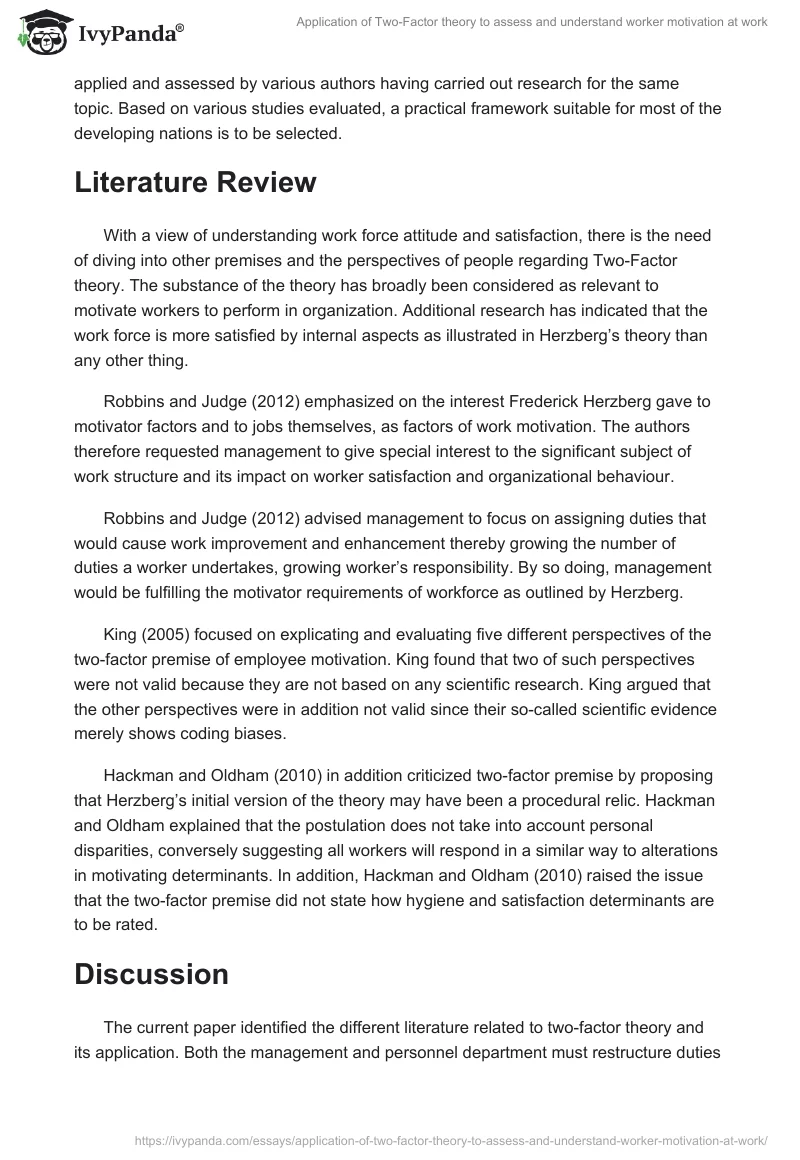Introduction
There are many motivation premises that have affected the manner in which companies manage workers in achieving an inspired work force. Such theories focus on explaining why individuals behave the way they do and provide information on aspects and policies which when adopted can get the best out of people as far as their dedication to work is concerned.
Due to the complexity of the concerns worth looking into when motivating individuals, it is always a difficult undertaking when it comes to companies encouraging employees for efficient outcome. Amoako (2011) argues that the issue of what encourages employees to work efficiently is a difficult one to address. In fact, a motivation is something, which propels an individual to perform, an explanation for behaviour.
Frederick Herzberg in an attempt to comprehend this issue and the aspect of work force satisfaction and encouragement in the 1970s embarked on determining the impact of mind-set on motivation through requesting individuals to tell circumstances where they felt very encouraged and very discouraged regarding their day to day duties (George & Jones, 2005).
Herzberg discovered that individuals who felt motivated regarding their day to day duties gave very diverse feedbacks from the individuals who felt discouraged. The findings formed the foundation of the Two-Factor Premise. The conclusions Herzberg got from such a theory were very significant and still form the basis of good motivational work force policies in contemporary organizations (Vroom & Deci, 2009).
This paper examines the literature that deals with application of two-factor theory. The research in addition makes an effort of understanding how the theory has been applied and assessed by various authors having carried out research for the same topic. Based on various studies evaluated, a practical framework suitable for most of the developing nations is to be selected.
Literature Review
With a view of understanding work force attitude and satisfaction, there is the need of diving into other premises and the perspectives of people regarding Two-Factor theory. The substance of the theory has broadly been considered as relevant to motivate workers to perform in organization. Additional research has indicated that the work force is more satisfied by internal aspects as illustrated in Herzberg’s theory than any other thing.
Robbins and Judge (2012) emphasized on the interest Frederick Herzberg gave to motivator factors and to jobs themselves, as factors of work motivation. The authors therefore requested management to give special interest to the significant subject of work structure and its impact on worker satisfaction and organizational behaviour.
Robbins and Judge (2012) advised management to focus on assigning duties that would cause work improvement and enhancement thereby growing the number of duties a worker undertakes, growing worker’s responsibility. By so doing, management would be fulfilling the motivator requirements of workforce as outlined by Herzberg.
King (2005) focused on explicating and evaluating five different perspectives of the two-factor premise of employee motivation. King found that two of such perspectives were not valid because they are not based on any scientific research. King argued that the other perspectives were in addition not valid since their so-called scientific evidence merely shows coding biases.
Hackman and Oldham (2010) in addition criticized two-factor premise by proposing that Herzberg’s initial version of the theory may have been a procedural relic. Hackman and Oldham explained that the postulation does not take into account personal disparities, conversely suggesting all workers will respond in a similar way to alterations in motivating determinants. In addition, Hackman and Oldham (2010) raised the issue that the two-factor premise did not state how hygiene and satisfaction determinants are to be rated.
Discussion
The current paper identified the different literature related to two-factor theory and its application. Both the management and personnel department must restructure duties and roles so that novel challenges are presented to employees on a day to day basis. This, Herzberg considered as ‘Job Enhancement’, that is, replacing routine duties with innovative jobs.
Also, it is important for management in assuring their workers of proportionate salary but critical to indicate to workers that remuneration is determined purely by performance and that ‘gratuities’ and other allowances are given based on employee commitment. This approach motivates a worker to stretch himself/herself for the good of his/her organization knowing that he/she will be remunerated adequately (Jaeger & Kanungo, 2008).
Conclusion
The paper has examined the different approaches in which different people have conducted their respective studies in relation to two-factor theory and its application. As Frederick Herzberg illustrated in the two-factor theory, it does not consider only the organizations aspects to encourage workers neither does it consider the hygiene aspects in increasing motivation. In motivating and satisfying workers, management should effectively mix the components well to satisfy the unique needs of its work force.
References
Amoaka, K. (2011). Application of Frederick Herzberg’s Two-Factor theory in assessing and understanding employee motivation at work: a Ghanaian Perspective. European Journal of Business and Management, 3(9), 89-98.
George, J., & Jones, R. (2005). Understanding and managing organizational behavior (4th ed.). Pearson Prentice, New York: McGraw-Hill.
Hackman, J. & Oldham, R. (2010). Motivation through design of work. Organisational behaviour and human performance, 16(2), 250–279.
Jaeger, M., & Kanungo, N. (2008). Management in developing countries. London: Routledge.
King, N. (2007). Clarification and Evaluation of the Two-Factor Theory of Job satisfaction. Psychological Bulletin, 74(1), 18-31.
Robbins, S., & Judge, T. (2012). Essentials of Organization Behavior (11th ed.). New Jersey: Prentice Hall.
Vroom, V. & Deci, E. (2009). Management and motivation. Organisational Behaviour and Human Resource Performance, 8(2), 217-229.


